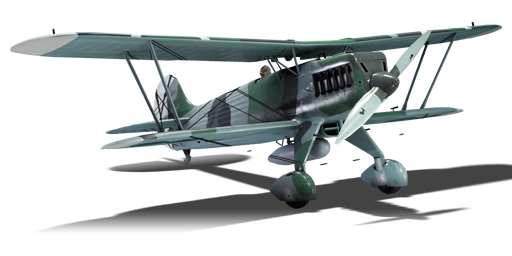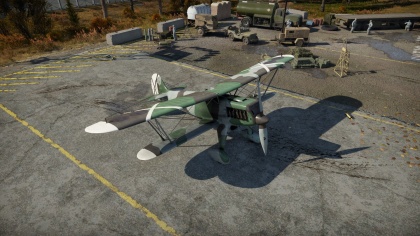He 51 B-1
Contents
| This page is about the German biplane He 51 B-1. For other versions, see He 51 (Family). |
Description
The He 51 B-1 is a rank I German fighter
with a battle rating of 1.0 (AB/RB/SB). It has been in the game since the start of the Open Beta Test prior to Update 1.27.
The Heinkel H 51 was one of the first aircraft which the German Luftwaffe (still operating in secrecy) tasked to be built. Brothers and talented aircraft designers Walter and Seigfried Günter were working for Heinkel Flugzeugwerke in 1931 when they developed the design for an advanced trainer biplane which was designated He 49. Though touted as a trainer, the aircraft had been designed as a fighter and with a few minor conversions, could be an operational fighter aircraft. After several iterations, the Luftwaffe ordered this aircraft into production as the He 51 in 1933.
Currently in service with Germany was the older Arado Ar 65 biplane which the He 51 was slated to replace, unfortunately by the time the He 51 A rolled off the production lines, it was already outdated, however, it wasn’t until after 150 were built that important modifications were made which resulted in the upgraded He 51 B. Of the 450 B variants built, 46 of them were modified by replacing the fixed landing gear with floats to allow the fighter to land on water. Later another 100 were built as the He 51 C variant which was configured as a light ground-attack aircraft.
Used initially in the Spanish Civil War, the He 51 showed to dominate over older biplanes, however, the advantage was short-lived as modern Soviet fighters and bombers arrived and the He 51 could no longer keep up with them. Operations for the He 51 converted to night fighting, however not long after that it was designated solely for ground attack operations. Though not seen as a fantastic aircraft, behind the scenes it had set the stage for the Luftwaffe years later when close support tactics were developed by Field Marshal Wolfram von Richthofen while flying a He 51.
When paired up against other reserve fighters in the game, the He 51 can hold its own, though it will not win any speed records, nor will its machine guns out fire some of the early Soviet fighters, however, there is a place for the He 51 B-1. Diving straight into a cluster of fighters rolling around with each other is not the best tactic, it is better to pick a target and go after it, however, if cornered, the slower speed and manoeuvrability of the He 51 can get it out of tight spaces and potentially down a few enemy aircraft in the process. With two 7 mm machine guns, tracer rounds work best against early aircraft, especially those which are fabric covered and have non-sealing fuel tanks. Though the pilot may find themselves up-tiered against mono-wing aircraft of faster speeds, the He 51 B-1 can quickly turn the tables and put the faster enemy fighter on the receiving end of a stream of bullets, and only a few hits are enough to hobble the enemy aircraft allowing the Heinkel to catch up and finish the job.
General info
Flight performance
Describe how the aircraft behaves in the air. Speed, manoeuvrability, acceleration and allowable loads - these are the most important characteristics of the vehicle.
| Characteristics | |||||||
|---|---|---|---|---|---|---|---|
| Stock | |||||||
| Max Speed (km/h at 4,000 m) |
Max altitude (meters) |
Turn time (seconds) |
Rate of climb (meters/second) |
Take-off run (meters) | |||
| AB | RB | AB | RB | AB | RB | ||
| 297 | 287 | 7700 | 14.9 | 15.8 | 11.7 | 11.7 | 294 |
| Upgraded | |||||||
| Max Speed (km/h at 4,000 m) |
Max altitude (meters) |
Turn time (seconds) |
Rate of climb (meters/second) |
Take-off run (meters) | |||
| AB | RB | AB | RB | AB | RB | ||
| 320 | 310 | 7700 | 14.6 | 14.7 | 17.9 | 14.2 | 294 |
Details
| Features | ||||
|---|---|---|---|---|
| Combat flaps | Take-off flaps | Landing flaps | Air brakes | Arrestor gear |
| ✓ | ✓ | ✓ | X | X |
| Limits | ||||
|---|---|---|---|---|
| Wing-break speed (km/h) |
Gear limit (km/h) |
Combat flaps (km/h) |
Max Static G | |
| + | - | |||
| 520 | ~11 | ~5 | ||
| Optimal velocities | |||
|---|---|---|---|
| Ailerons (km/h) |
Rudder (km/h) |
Elevators (km/h) |
Radiator (km/h) |
| < 180 | < 300 | < 300 | > 190 |
| Compressor (RB/SB) | ||
|---|---|---|
| Setting 1 | ||
| Optimal altitude | 100% Engine power | WEP Engine power |
| 0 m | 750 hp | N/A |
Survivability and armour
Examine the survivability of the aircraft. Note how vulnerable the structure is and how secure the pilot is, whether the fuel tanks are armoured, etc. Describe the armour, if there is any, and also mention the vulnerability of other critical aircraft systems.
Armaments
Offensive armament
The He 51 B-1 is armed with:
- 2 x 7.92 mm MG 17 machine guns, nose-mounted (500 rpg = 1,000 total)
Usage in battles
Describe the tactics of playing in an aircraft, the features of using aircraft in a team and advice on tactics. Refrain from creating a "guide" - do not impose a single point of view, but instead, give the reader food for thought. Examine the most dangerous enemies and give recommendations on fighting them. If necessary, note the specifics of the game in different modes (AB, RB, SB).
Manual Engine Control
| MEC elements | ||||||
|---|---|---|---|---|---|---|
| Mixer | Pitch | Radiator | Supercharger | Turbocharger | ||
| Oil | Water | Type | ||||
| Controllable | Not controllable Not auto controlled |
Not controllable Not auto controlled |
Controllable Not auto controlled |
Combined | Not controllable 1 gear |
Not controllable |
Modules
| Tier | Flight performance | Survivability | Weaponry | |
|---|---|---|---|---|
| I | Fuselage repair | Radiator | Offensive 7 mm | |
| II | Compressor | |||
| III | Wings repair | Engine | Airframe | New 7 mm MGs |
| IV | Cover | |||
Pros and cons
Pros:
- Free repairs
- Excellent turn rate
- Freely available at the start of the game in the German aircraft tech-tree
Cons:
- Slow, and as a consequence lousy at climbing
- Pathetic armament for a fighter with only 2 x 7.92 mm machine guns
- Bad forward visibility in the cockpit, noticeable while dogfighting in simulator battles
- Any success a player may have in the plane can largely be attributed to being pitted against similarly shabby aircraft and inexperienced pilots due to its battle rating
History
Describe the history of the creation and combat usage of the aircraft in more detail than in the introduction. If the historical reference turns out to be too long, take it to a separate article, taking a link to the article about the vehicle and adding a block "/ History" (example: https://wiki.warthunder.com/(Vehicle-name)/History) and add a link to it here using the main template. Be sure to reference text and sources by using <ref></ref>, as well as adding them at the end of the article with <references />. This section may also include the vehicles's dev blog entry (if applicable) and the in-game encyclopedia description (under === In-game description ===, also if applicable).
In-game description
Heinkel He 51 B-1 single-engine fighter
In the spring of 1935, a new fighter variant, the He 51 B-1, was launched into production. It differed from the "A" version in that it had reinforced twin braces and a fuselage rack to mount a 170-litre external fuel tank.
By the spring of 1936, the new version replaced the He 51 A-1 on the production lines. Heinkels were the main Luftwaffe fighters at the time. The He 51 ended up at the centre of a boisterous propaganda campaign developed by the Reich Ministry of Public Enlightenment and Propaganda around the reviving Luftwaffe. However, the He 51 was not commercially successful on the foreign market.
In 1935, after they failed to obtain a licence for the Polish P.24 monoplane fighter, the Hungarian government turned to Heinkel with a request to consider the possibility of producing the He 51 with a French 850 hp Gnome-Rhone 14K engine. Despite the powerful engine, this variant's test results did not satisfy the Hungarians, and they chose to purchase Italian CR.42 fighters instead of Heinkels.
The He 51's career as the main Luftwaffe fighter, meanwhile, started to decline. In January 1936, a series of training duels took place between the Ar 68, a new fighter by Arado Flugzeugwerke, and the He 51. The series was lost by the Heinkel fighter, as it was significantly inferior to its opponent in manoeuvrability, rate of climb, and maximum speed.
As front-line fighter wings were being rearmed with new equipment, the He 51s were handed over to units intended to provide direct air support for ground forces. They did not stay there too long and were soon delivered to training units, where the He 51s were used for training fighter pilots throughout the entirety of World War II.
At the end of the war, He 51s were occasionally used as light night bombers against Red Army units or for anti-guerrilla purposes. Their efficiency in this capacity was deemed unsatisfactory, and the He 51s did not win any fame as night bombers.
Media
Excellent additions to the article would be video guides, screenshots from the game, and photos.
See also
- Aircraft of comparable role, configuration and era
External links
Paste links to sources and external resources, such as:
- topic on the official game forum;
- encyclopedia page on the aircraft;
- other literature.
| Germany fighters | |
|---|---|
| Heinkel | |
| He 51 | He 51 A-1 · He 51 B-1 · He 51 B-2/H · He 51 C-1 · He 51 C-1/L |
| He 100 | He 100 D-1 |
| He 112 | He 112 A-0 · He 112 B-0 · He 112 B-1/U2 · He 112 B-2/U2 · He 112 V-5 |
| Messerschmitt | |
| Bf 109 (Jumo) | Flegel's Bf 109 A · Bf 109 B-1 · Bf 109 C-1 · Bf 109 C-1 |
| Bf 109 (DB-601) | Bf 109 E-1 · Bf 109 E-3 · Bf 109 E-4 · Bf 109 E-7/U2 · Bf 109 F-1 · Bf 109 F-2 · Bf 109 F-4 · Bf 109 F-4/trop |
| Bf 109 (DB-605) | Bf 109 G-2/trop · Bf 109 G-2 · Bf 109 G-6 · Bf 109 G-10 · Bf 109 G-14 · Bf 109 K-4 |
| Focke-Wulf | |
| Fw 190 (early) | Fw 190 A-1 · Fw 190 A-4 · Fw 190 A-5 · Fw 190 A-5 · Fw 190 A-5/U2 · Fw 190 A-5/U14 · Fw 190 A-8 · Fw 190 C |
| Fw 190 (late) | Fw 190 D-9 · Fw 190 D-12 · Fw 190 D-13 |
| Ta 152 | Ta 152 C-3 · Ta 152 H-1 |
| Blohm & Voss | |
| BV 155 | BV 155 B-1 |
| Captured: | |
| USA | ▀P-47D-16-RE · ▀P-47D |
| USSR | ▀La-5FN · ▀Yak-1B |
| Britain | ▀Tempest Mk V |
| Italy | |
| CR.42 | ▀CR.42 · ▀Marcolin's C.R.42 CN |
| G.50 | ▀G.50 serie 2 · ▀G.50 AS serie 7 |
| C.200 | ▀C. 200 serie 3 · ▀C. 200 serie 7 |
| C.202 | ▀C. 202 |
| Finland | ▀Hawk H-75A-2 |





